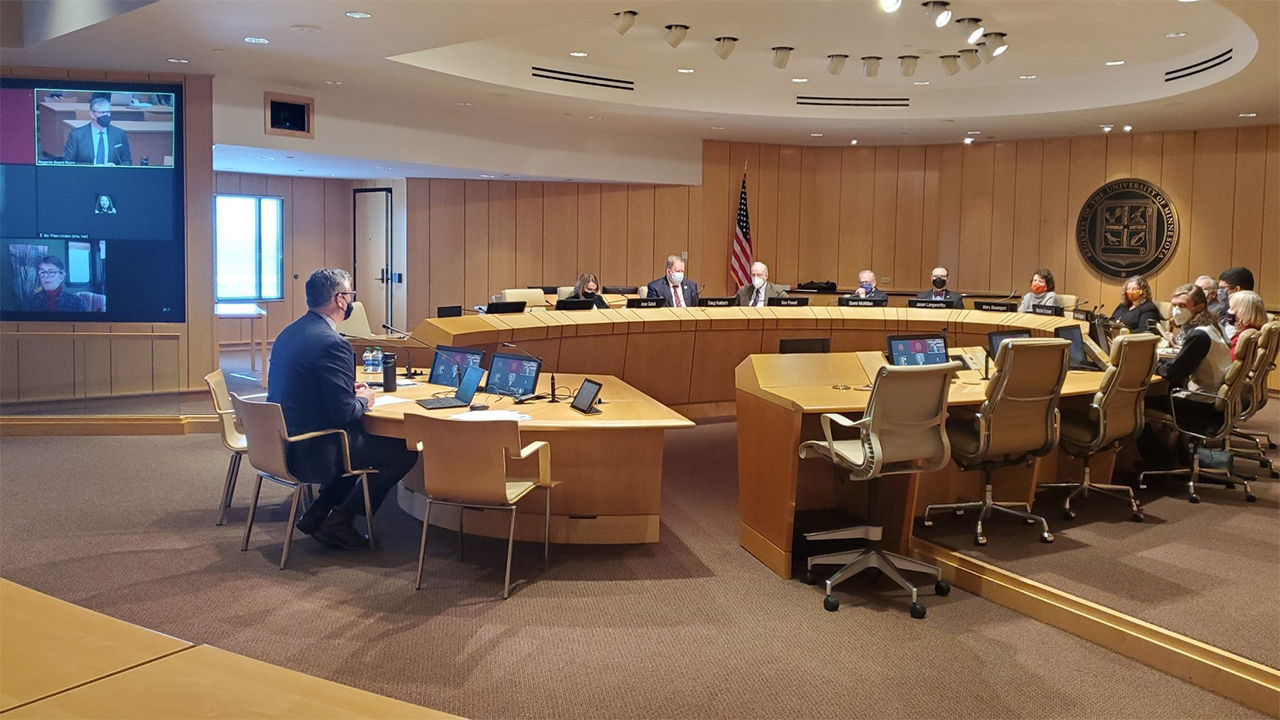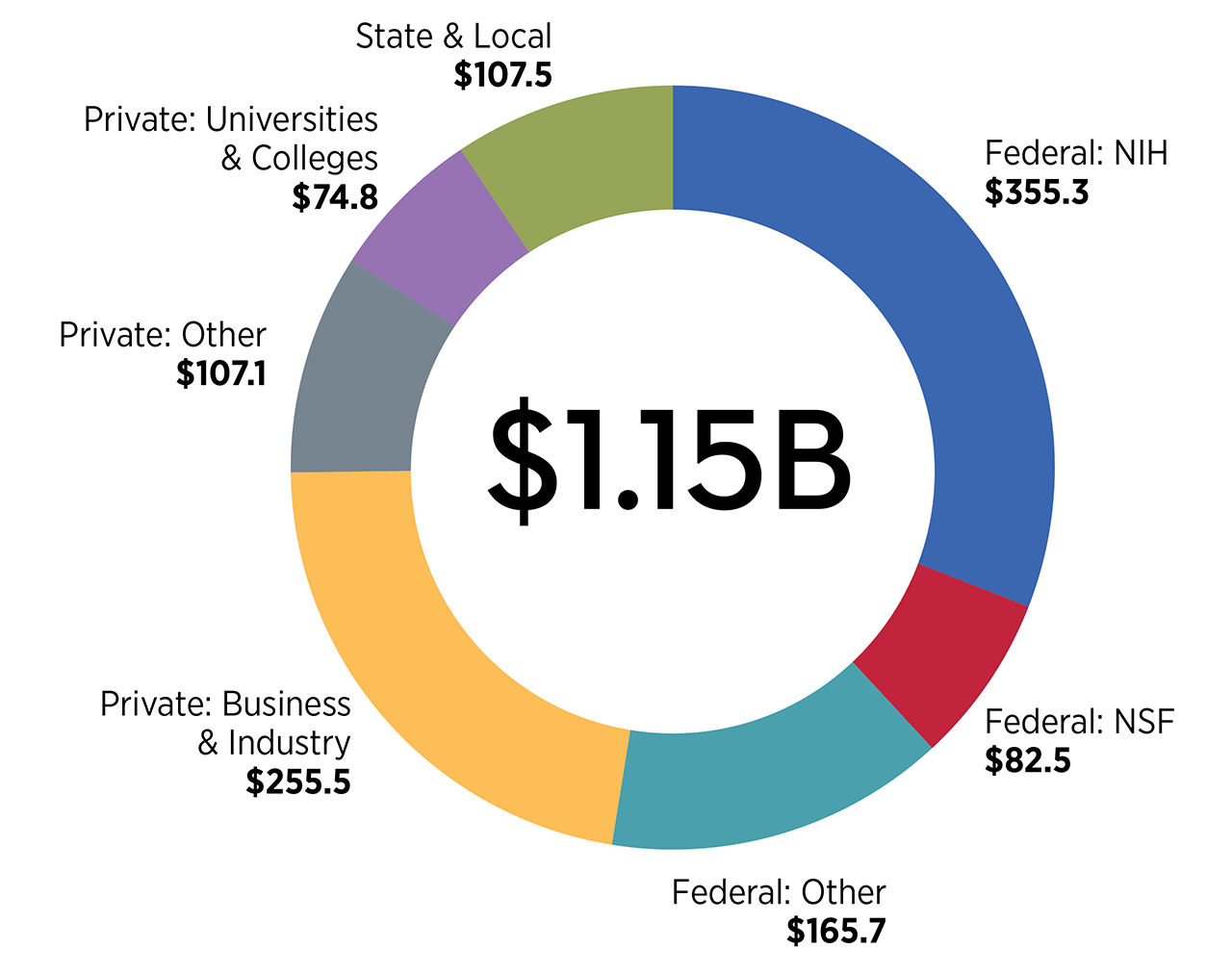
The University of Minnesota’s research enterprise is strong, growing, and impactful, despite COVID-19, according to Interim Vice President for Research Michael Oakes, who delivered the Annual Report on Research and Technology Commercialization to the University’s Board of Regents, on Thursday, December 16, 2021.
“One of the most exciting things I get to share this morning is the amazing work this organization has done in this very challenging period,” Oakes said. “I’m delighted and really privileged to share that, even in the face of the pandemic, the University's research community received awards of $1.15 billion—that's a record that's quite extraordinary and we have a lot to be proud of.”
Oakes gave his talk an alternate title, the State of the Research Enterprise, to signal that he would be providing thoughts about the role and future of research at the University as well as a retrospective look at Fiscal Year 2021. He included illustrative stories about COVID-19 work, corporate engagement with Cisco Systems, startup company Låkril Technologies, a major humanities initiative on racial justice, a cancer prevention collaborative with the Somali women, and greener and more profitable processing of iron waste.
The $1.15 billion in external funding total for fiscal year 2021 pushed the University past the $1 billion award mark for the first time in history. As is typically the case, the National Institutes of Health was the largest single external funder of research, providing $355 million in awards, followed by the National Science Foundation, with $83 million in awards.
Responding to the greatest public health threat of our time, University researchers in many diverse fields attracted $256 million in COVID-19 related awards, which included $152 million in awards from NIH for international clinical trials of possible COVID-19 treatments (the funding came to the University via the Leidos corporation).
Oakes highlighted the University’s well diversified awards portfolio with a chart showing awards levels from federal agencies, the State of Minnesota, business & industry, foundations, and other sources.
Awards by Source
FY21, All Campuses, $ millions

Continued Success in Technology Transfer and Corporate Engagement
The University’s technology transfer activities also saw continued success, Oakes reported. UMN Technology Commercialization’s Venture Center launched a record 20 startup companies, with 14 based in Minnesota. Since 2006, the University has launched more than 190 startups across many economic sectors with a high rate of success. The University signed 236 new licensing deals (one more than last year) and ended the year with 575 current revenue-generating agreements.
Oakes also highlighted the growing success of the University’s Corporate Engagement Center, which he leads with the University of Minnesota Foundation. As an example, he described the University’s recent collaboration with Cisco Systems, which has thus far led to 14 University projects in areas that leverage UMN strengths (health care, machine learning, and edge computing) supported by the networking giant.
“There's just unprecedented collaboration between my office and the Foundation to really work on relationship management, so corporations have one point of entry. It’s almost a concierge service for when, say, Honeywell or Cisco calls,” Oakes said, adding that he had reorganized within his own office’s units to better meet the needs of potential partner companies.
University Research Successes aligned with Key Measures of MPact 2025
Oakes outlined for the regents how the University’s research success was aligned with key measures set out in MPact 2025, the University’s systemwide strategic plan. Oakes expressed confidence that the University research community was making good progress, despite the volatility of some measures year-over-year, and the unforeseen effects of the COVID-19 pandemic.
He said he was also excited with the MPACT 2025’s plans to emphasize more impactful research in Minnesota’s communities through an initiative called MNtersections. “I really want us to be a problem-solving university, with all that implies,” Oakes said.
Oakes Seeks Additional Efficiencies and Responsiveness in Research Services, But Calls Underinvestment in Services a “Real Threat”
Oakes presented how the Office of the Vice President for Research, which includes Sponsored Research Administration, the Institutional Review Board (IRB), and a new unit called the Risk Intelligence and Compliance Team (RIACT), are examining their responsiveness to the needs of researchers and their efficiency in cooperation with the University’s PEAK Initiative. He highlighted how the IRB, in cooperation with the Medical School, has been reducing study review times while still maintaining high standards for potential studies with human participants.
“I want to emphasize that we're trying to use more data analytics in this space,” Oakes said.
In a portion of his presentation dedicated to the outlook for the research enterprise, Oakes highlighted that there is room for growing the University’s share of federal funding for research and he shared some strategies he believes the University needs to implement in order to grow its research portfolio, including creating shared research facilities, strategic internal investments, and internal teams that can help faculty compete for funding beyond their usual sources.
He cautioned that success in growing the research enterprise will eventually outstrip even the most efficient institution’s administrative capacity and infrastructure, necessitating new investments in both areas. “The long-term threat, I think, is underinvestment,” he said. “As we grow the research enterprise, some of the costs will have to go up with it.”
Watch Oakes’ presentation at the UMN Board of Regents Mission Fulfillment Committee – Transcript of the presentation. Find 2021 UMN Research Statistics, along with a Research At-A-Glance summary, Annual Report Top Five, Technology Commercialization Statistics, and the 2021 Annual Report on Technology Commercialization.